Menu

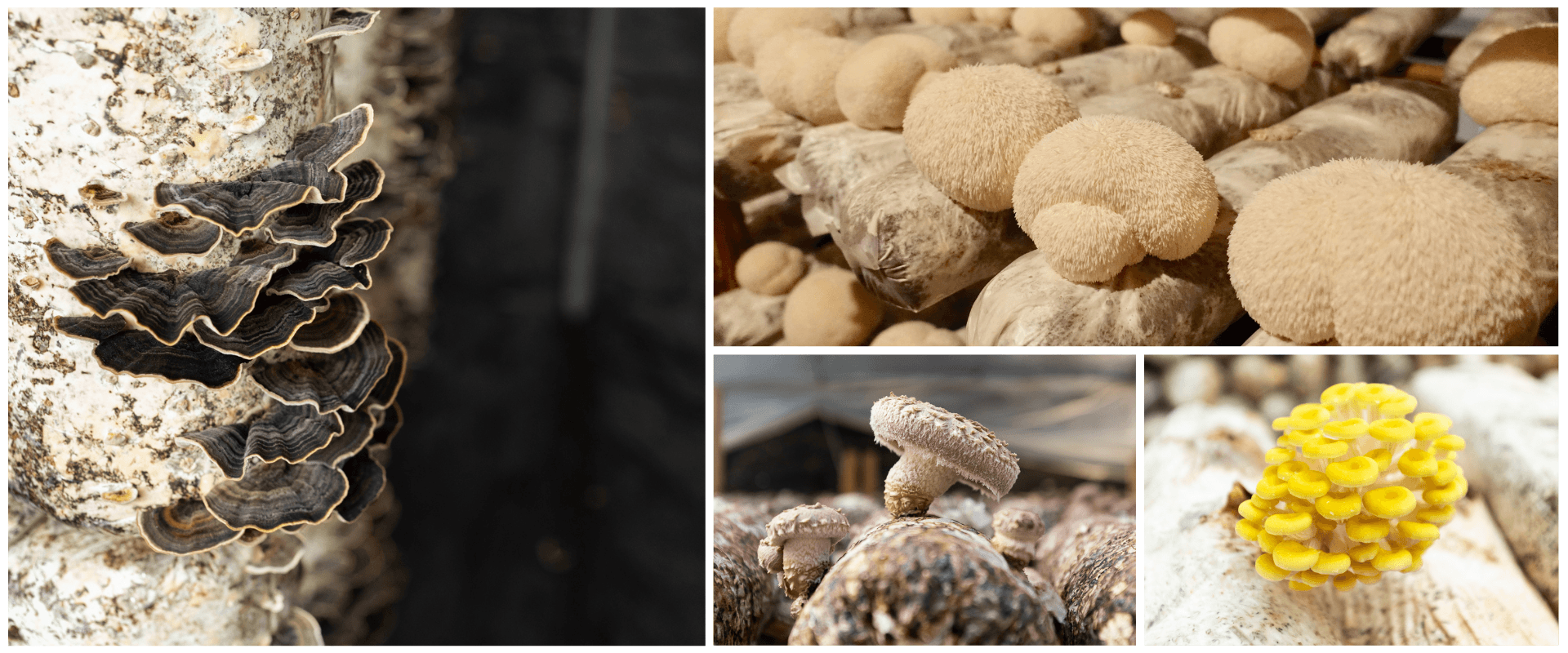

Selecting the right substrate is a cornerstone of successful mushroom cultivation. The quality of the growing medium can significantly impact the growth characteristics and overall yield of mushrooms. A well-chosen substrate doesn’t just support healthy growth—it can determine the overall success of your harvest.
Whether you’re a first-time grower experimenting with home cultivation or a seasoned hobbyist looking to optimize your setup, this guide will walk you through everything you need to know about choosing the best substrate for mushrooms.
By the end, you’ll have a clear understanding of different substrate types, their benefits, and how they impact mushroom development, setting you up for a thriving and rewarding growing experience.
Mushroom substrates are foundational to the cultivation process, acting as the primary food, water source, and structural base for fungal growth.
Simply put, they are organic materials that fungi metabolize to thrive. Without a suitable substrate, the efficiency, health, and yield of mushrooms can be compromised [1], leaving growers with suboptimal results. But why is this so?
A mushroom's lifecycle begins with its mycelium—the dense, root-like network of fungal cells that colonizes organic material. The substrate is the mycelium’s fuel source and environment, dictating how well it spreads and ultimately fruits. Let’s break down its three main roles in cultivation:
Substrates provide the nutrients needed for mycelium growth and eventual fruiting [2]. Fungi use enzymes to break down the materials into simple compounds they can absorb.
Every mushroom species relies on a balanced substrate composition for healthy mycelial development. Key nutrients like carbon, nitrogen, and lignin are essential, with carbon serving as an energy source and nitrogen supporting protein and enzyme synthesis.
Studies have shown that a carbon-to-nitrogen (C/N) ratio of approximately 30:1 is optimal for colonization and growth [3]. Substrates with excessive carbon or nitrogen can hinder yield and fungal health.
Fungi require a moist environment to function. Substrates act as a water reservoir, maintaining consistent hydration critical for colonization and fruiting.
Proper water content allows the mycelium to secrete enzymes necessary for breaking down the substrate and absorbing nutrients, turning it into rich, loamy compost once the mushrooms have fruited.
Most mushroom substrates should maintain 55–65% moisture [9]. This balance prevents desiccation while avoiding waterlogging, which could reduce oxygen availability and lead to contamination by anaerobic organisms.
For mushroom growers, a well-hydrated substrate optimizes enzyme activity and supports healthy mycelium development. Substrates that are too dry restrict nutrient absorption, while overly wet substrates can suffocate the mycelium or encourage mold growth.
Spent mushroom substrate, after cultivation, can be recycled as an excellent organic amendment for soil, enhancing its nutrient-rich quality and sustainability in agricultural applications.
Beyond nutrition and hydration, a well-structured substrate ensures proper airflow and provides enough rigidity for the mushrooms (fruiting bodies) to develop.
Fungi grow best in substrates with a porous structure that allows for oxygen circulation. For instance, coarser materials like straw create air pockets, ensuring better gas exchange.
Without adequate structure in the substrate, mushrooms may fail to fruit, even if nutrient levels are optimal. Turkey tail mushrooms, for example, require a firm, lignin-rich base like hardwood sawdust to grow.
Whether grown indoors, outdoors, or on an industrial scale, using the fruiting body of mushrooms instead of alternatives like myceliated grain may result in varying concentrations of compounds like beta-glucans, which are naturally present in mushrooms.
Choosing the right substrate is key to aligning growth conditions with the needs of each species. Up next, we’ll explore how to match specific mushroom varieties to their ideal substrate for optimal results.
Different mushroom species have evolved to metabolize specific materials found in their natural environments. By mimicking these conditions in cultivation, you can provide the nutrients, moisture, and support needed for optimal growth and fruiting.
Choosing the right substrate tailored to each mushroom variety plays a crucial role in ensuring healthy mycelium colonization, high yields, and robust fruiting bodies.
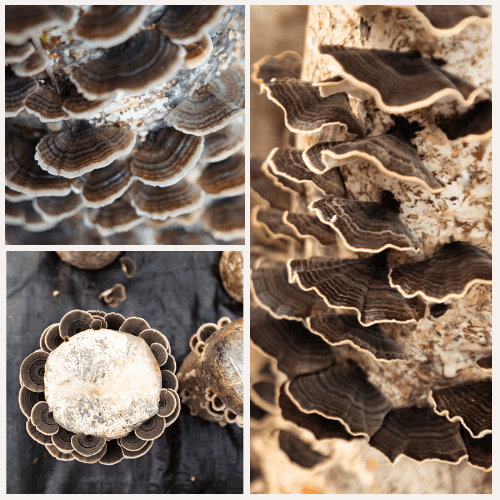
Turkey tail mushrooms thrive on hardwood substrates like oak or maple sawdust, utilizing their lignin-degrading enzymes, such as laccase, to break down complex plant polymers.
Substrates supplemented with nitrogen-rich bran can improve colonization and yields by balancing the carbon-to-nitrogen (C/N) ratio to around 30:1, an ideal range for wood-decaying fungi. These substrates support healthy growth and may influence the levels of compounds such as polysaccharide-K, a naturally occurring component in fungi
These substrates support optimal growth and enhance bioactive compound concentrations, such as polysaccharide-K, known for its immune-supporting properties.

Oyster mushrooms adapt well to cellulose-rich substrates like straw, coffee grounds, cardboard, or coco coir, relying on cellulase enzymes to digest plant fibers.
Straw stands out for its high cellulose and hemicellulose content [6], offering affordability and accessibility. Coffee grounds provide an additional nutrient boost. Straw substrates, in particular, have also demonstrated biological efficiencies, outperforming other options like cardboard.

Shiitake mushrooms grow best on lignin-rich hardwood logs such as oak or chestnut, with outdoor log cultivation producing dense, high-quality fruiting bodies over 6-9 months.
Alternatively, hardwood sawdust blocks supplemented with bran [8] significantly reduce colonization times while maintaining yields.
Adding wheat bran to sawdust has been shown to improve shiitake yields, though log-grown mushrooms are still prized for their superior texture and flavor.
Button mushrooms require nutrient-dense compost made from straw and manure, decomposed to release nitrogen and ammonium ions.
Properly composted substrates stabilize nitrogen levels around 2.0–2.5% [4], creating an optimal growth environment while reducing pathogens. This preparation supports high biological efficiencies [5], enabling consistent yields in controlled settings.
Using substrates that mimic a mushroom's natural habitat encourages faster colonization, lowers contamination risks, and improves yields.
As research continues to highlight the impact of substrate composition on yield and nutritional quality, the importance of thoughtful selection becomes clear. Next, we’ll explore how natural and synthetic substrates compare and how to choose the best option for home growing.
Mushroom substrates can be broadly categorized into natural or synthetic materials, each offering distinct advantages depending on the grower’s skill level, goals, and available resources.
Natural substrates, such as straw or a large compost pile enriched with nutrients, are often favored by hands-on or sustainability-focused growers seeking a more eco-friendly approach.
On the other hand, synthetic substrates provide a pre-made substrate mix that simplifies the process, making them an appealing option for beginners looking to start mushrooms growing with less preparation.
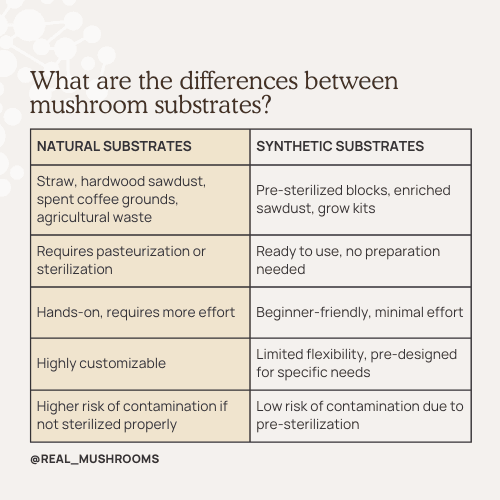
Natural substrates, such as straw, hardwood sawdust, and coffee grounds, are low-cost, accessible, and environmentally friendly. Recycling these materials also reduces waste and biological efficiency for mushrooms.
However, natural substrates require pasteurization or sterilization to prevent contamination from mold or bacteria. This can be labor-intensive and time-consuming, particularly for larger batches.
Substrates like straw often benefit from supplementation with nitrogen-rich additives to maintain a carbon-to-nitrogen ratio (~30:1), which supports the growth of species like turkey tail mushrooms.
Synthetic substrates, such as pre-sterilized nutrient blocks or grow kits, are easy to use and eliminate the need for time-consuming preparation.
Pre-mixed with the right nutrients and hydration, they reduce contamination risks and are ideal for beginners cultivating species like oyster or button mushrooms.
However, synthetic options are more expensive due to manufacturing and have a larger environmental footprint because of production and packaging. They also lack flexibility, making customization for specific mushroom species difficult, which may not suit advanced or sustainability-focused growers.
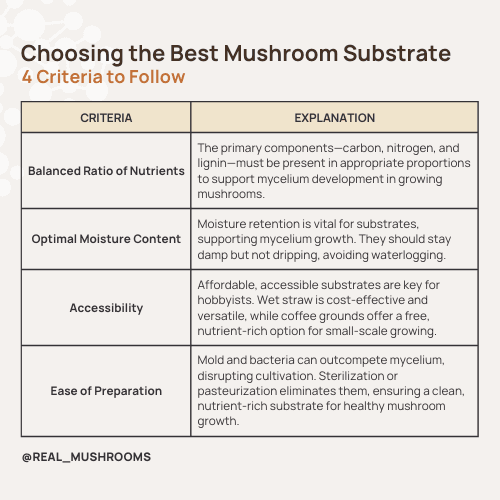
To set yourself up for success, use these criteria to select the best substrate for your mushroom species:
Every mushroom species has unique nutritional needs, making substrate composition a critical consideration in mushroom culture. The primary components—carbon, nitrogen, and lignin—must be present in appropriate proportions to support mycelium development in growing mushrooms.
Carbon-rich materials like cellulose and lignin provide fungi with the energy needed to break down substrates, while nitrogen is essential for protein and enzyme synthesis.
Less nutritious substrates, such as plain straw or untreated agricultural byproducts, may require supplementation with additives like bran or gypsum to achieve the right nutrient balance and improve colonization.
To ensure optimal performance, substrates must achieve an ideal carbon-to-nitrogen (C/N) ratio, which varies by species. Balanced substrates allow mushroom spawn to colonize effectively, promoting efficient growth and higher yields.
Adequate moisture retention is essential for substrate performance, as it supports enzymatic activity and the healthy development of mushroom mycelium. Substrates must retain moisture while avoiding waterlogging, maintaining what mushroom growers call "field capacity"—damp but not dripping when squeezed.
Proper moisture retention in the substrate mix ensures an ideal environment for mushroom growth, allowing the fungi to absorb nutrients efficiently.
Excess moisture can reduce oxygen availability, creating anaerobic conditions that harm mycelium, while insufficient moisture can slow colonization and significantly reduce yields.
An excellent mushroom substrate balances these factors, helping to retain moisture effectively without compromising aeration or the overall health of the fungal network.
The affordability and availability of substrates are crucial for home growers and hobbyists. Wet straw, readily available in bales from agricultural stores, is widely used as a base for substrate recipes due to its cost-effectiveness and ability to support different mushroom species.
Coffee grounds, on the other hand, are a free and sustainable option that provides nitrogen and trace minerals, making them ideal for small-scale cultivation.
Supplementing substrates with additives like bran or seed derivatives can further enhance substrate nutrition by increasing nitrogen levels, which supports mushroom mycelium growth.
For more nutrient-rich options, chicken manure or partially digested food materials such as animal feed can be incorporated into compost piles or mixed with corn stalks to create a specialized substrate. These diverse substrate materials simplify cultivation while ensuring consistent results across grows, even for beginners.
For beginners, pre-made substrate kits or pasteurized substrate materials like straw simplify the process of growing mushrooms, greatly reducing the risk of contamination.
However, as growers gain experience, many choose to prepare mushroom substrates themselves using a variety of materials like sawdust, straw, or compost pile ingredients, allowing for more customization and control over the growing conditions.
Matching substrate preparation levels to one’s experience helps ensure smoother cultivation and increases the likelihood of a successful harvest. Creating your own substrate gives growers the flexibility to experiment with nutrient compositions and develop methods tailored to the specific needs of their mushrooms.
Sustainability Tip: Spent coffee grounds and agricultural waste like peanut shells can provide nutrients for mushrooms while reducing your carbon footprint. A 2017 SARE report even found coffee grounds to be a sustainable option for growing mushrooms!
Contaminants, such as mold, yeast, or harmful bacteria, can outcompete mycelium for nutrients, disrupting colonization and ruining months of cultivation effort. Mushroom substrate sterilization or pasteurization [7] is critical to eliminate living or dormant contaminants and create a clean, nutrient-rich environment that supports healthy fungal growth.
These processes significantly reduce competing microorganisms, ensuring the substrate is properly primed for successful mushroom production.
Using a pressure cooker at 121°C (250°F) and 15 PSI for 90 minutes is highly effective for preparing substrates like supplemented hardwood sawdust or compost.
This method eliminates resilient contaminants, including bacterial endospores, ensuring a sterile environment that promotes healthy mycelium colonization.
Considered one of the best mushroom substrate preparation methods for high-nutrient mixes, it is particularly suitable for materials like hardwood sawdust that are prone to contamination but essential for optimal mushroom growth.
Immersing most raw substrates, such as straw, in a hot water bath for 30–60 minutes significantly reduces pathogens while maintaining the integrity of the substrate structure.
Using temperatures between 140°F to 160°F (60°C to 71°C) is sufficient to eliminate microbial contaminants without compromising its suitability for mushroom spawn.
This method is both cost-effective and practical, especially for low- to medium-risk substrates [10] often used in small-scale growing setups.
Hydrated lime raises pH above 12, creating an alkaline environment that neutralizes bacteria and mold. Substrates like straw or coffee grounds are soaked for 12–24 hours and drained before use. This method is efficient and low-cost, but less effective against some spore-forming organisms.
Matching the sterilization method to your substrate's contamination risk ensures healthy mycelial colonization. Proper preparation reduces failure rates and increases the chances of a successful harvest.
Even minor mistakes during mushroom substrate preparation can disrupt mushroom cultivation and significantly reduce yields. Proper handling of fresh substrate is critical to provide the ideal environment for growing mushrooms. Here are some common pitfalls to avoid:
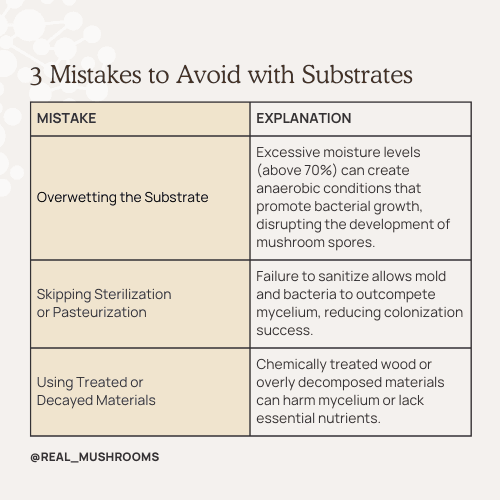
To ensure successful yields, always prioritize proper preparation of the mushroom substrate, as it provides the foundation for robust fungal growth.
Healthy mushroom cultivation starts with informed practices—selecting the right substrate, maintaining proper hydration, and ensuring sterility. They all play a key role in achieving robust, contamination-free harvests.
When it comes to functional mushrooms, quality is essential. Real Mushrooms guarantees that only 100% organic mushroom fruiting bodies are used in our products, with no added fillers or myceliated grain. Whether you're growing at home or exploring functional mushrooms for their health benefits, Real Mushrooms delivers unmatched quality backed by science.
Enhance your mushroom journey with Real Mushrooms' organic mushroom supplement line and educational resources. Experience the difference that high-quality ingredients and expertise can make.
These statements have not been evaluated by the Food and Drug Administration. This product is not intended to diagnose, treat, cure, or prevent any disease.

 .
.Disclaimer: The information or products mentioned in this article are provided as information resources only, and are not to be used or relied on to diagnose, treat, cure, or prevent any disease. This information does not create any patient-doctor relationship, and should not be used as a substitute for professional diagnosis and treatment. The information is intended for health care professionals only. The statements made in this article have not been evaluated by the Food and Drug Administration. Any products mentioned are not intended to diagnose, treat, cure, or prevent any disease. The information in this article is intended for educational purposes. The information is not intended to replace medical advice offered by licensed medical physicians. Please consult your doctor or health practitioner for any medical advice.